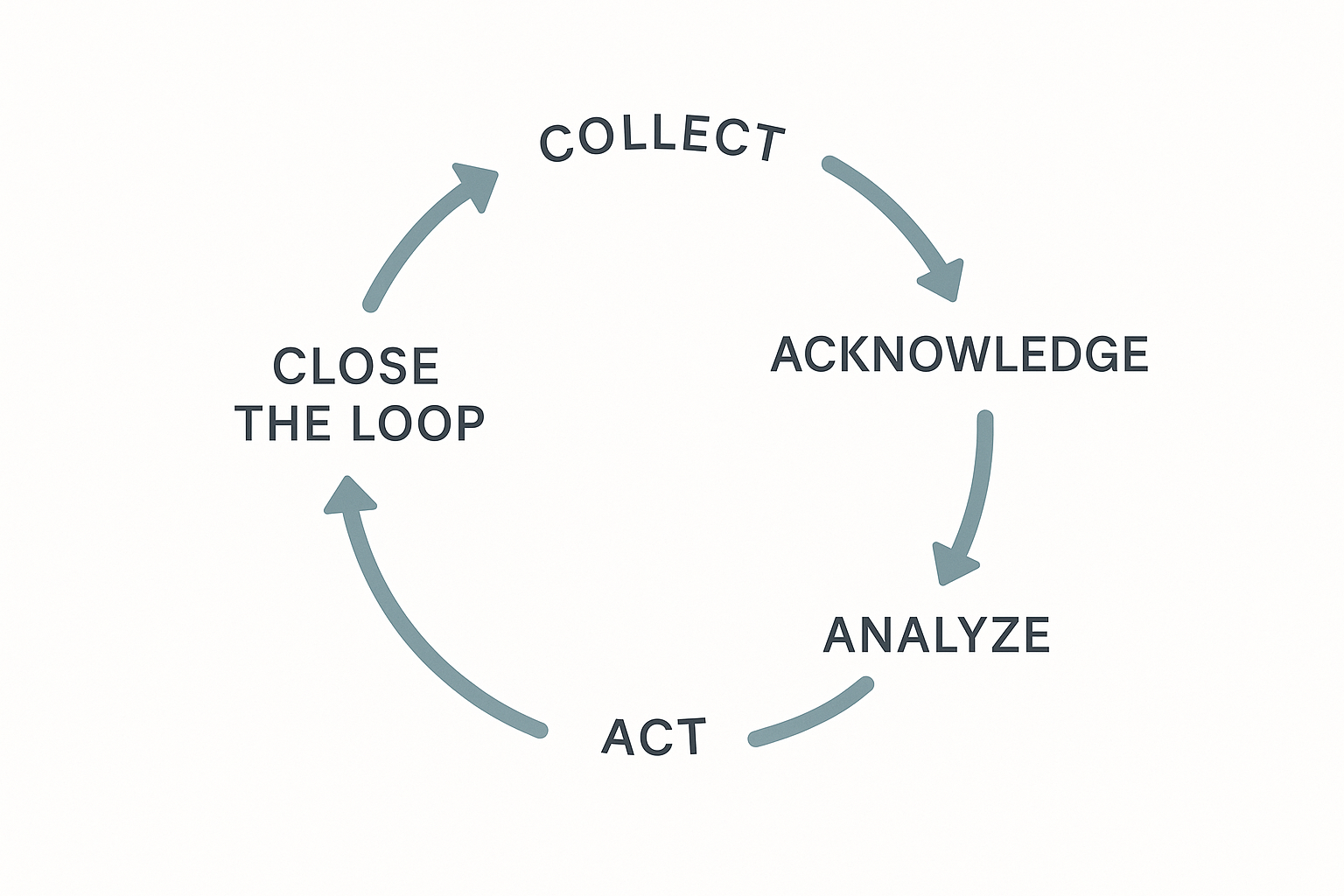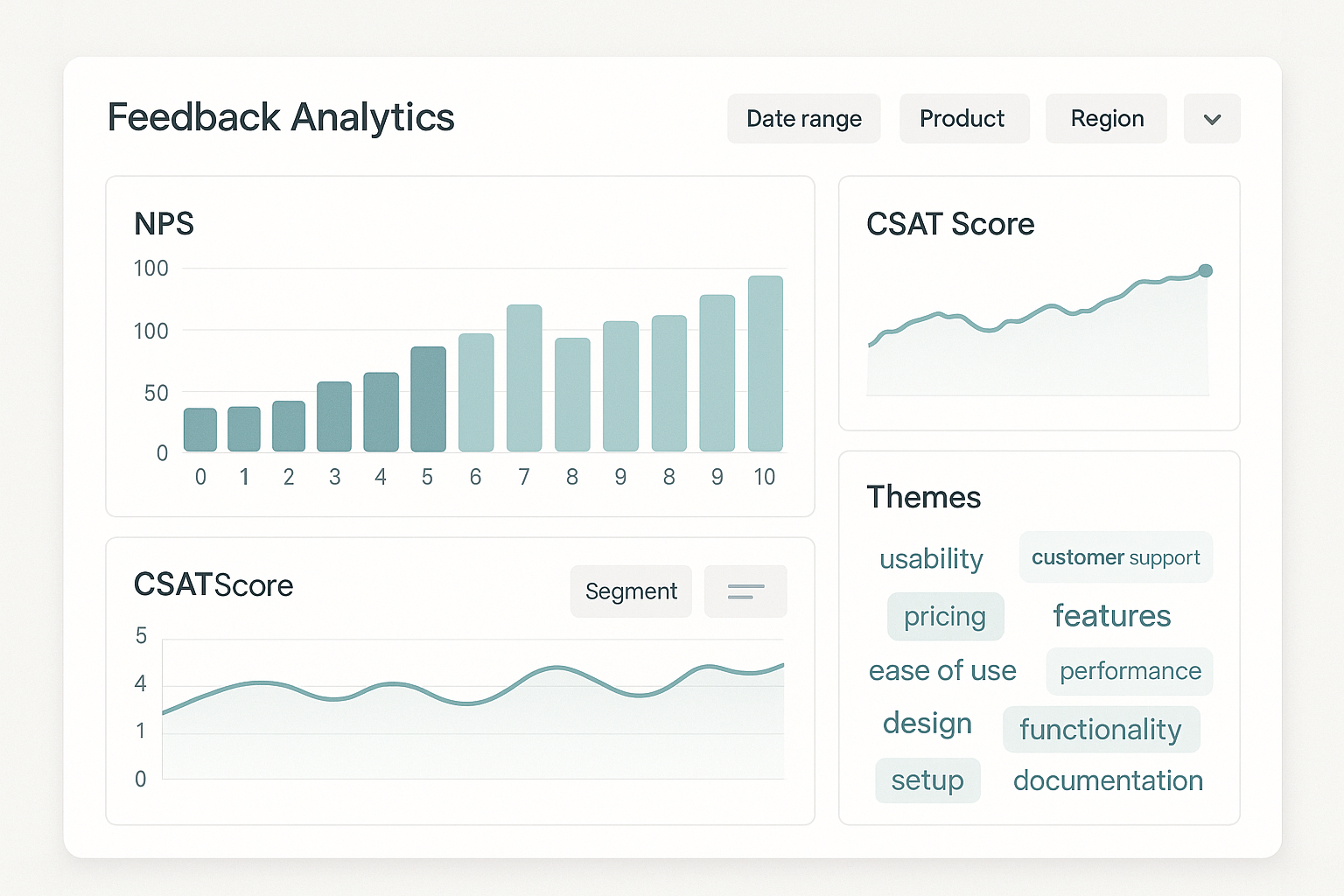# The quiet power of a closed loop
Most teams collect feedback. Fewer close the loop. A proper customer feedback loop turns scattered opinions into product decisions customers can feel. It is simple in structure and strict in practice: collect feedback, acknowledge it, analyze, act, then close the loop. When you run these steps with care, loyalty follows.

# What is a customer feedback loop?
A customer feedback loop is a repeatable workflow that captures input, turns it into insight, ships improvements, then tells customers what changed. The point is not volume, it is continuity. No black holes.
Short answer for the busy reader: collect, acknowledge, analyze, act, close.
# Step 1: Collect feedback with context
Feedback is only useful when it is specific and timely. Capture both quantitative and qualitative signals across channels.
- Surveys like NPS and CSAT for trend lines
- Interviews for depth and nuance
- Support tickets and live chat for friction points
- Reviews and social for unsolicited input
- In‑app feedback widgets for “in the moment” context
Prompt right after key actions, for example after onboarding or after a feature is used for the first time. Segment by lifecycle stage, region, or plan to keep context intact. For a clear rundown on multi‑channel collection, the Userpilot guide on building feedback loops breaks it down well, and Custify’s overview explains why timing the ask right after an action raises accuracy.
If you need an embedded widget and a public roadmap tied to real feedback, explore the feedback tools in Sleekplan’s features (opens new window).
# Step 2: Acknowledge feedback immediately
Silence feels like indifference. Thank people, even when the answer is “not now.” Automate a warm confirmation for routine submissions, then add a personal note when the signal is strong or the account is strategic. Kapiche’s guidance highlights how a simple, personal response shows respect and keeps the door open for future insight.
We keep a simple rule: every submission gets a reply within 24 hours, and significant insights get a named owner.
# Step 3: Analyze signals, not noise
Numbers show direction, words explain why. Use both.
- Quantitative: group NPS or CSAT by segment, watch deltas over time
- Qualitative: tag themes, cluster similar comments, surface root causes
- Segmentation: compare needs across roles, regions, and tiers

For a practical walkthrough of thematic analysis, the GetThematic guide is a solid reference. Tie analysis to your roadmap, not a spreadsheet island. The Aha! overview outlines how loops connect to planning, sprint reviews, and release notes. Human judgment still matters, especially when a small cohort shows a critical insight that volume masks.
Two signs your analysis is working: you can explain a trend in one sentence, and you can point to a single user quote that makes it real.
# Step 4: Act on insights with intention
Do not prioritize by microphone volume. Prioritize by strategic fit and customer value.
- Align work to product vision, not quick wins that bend the roadmap
- Choose improvements that reduce time to value or remove a recurring friction
- Document the decision and link the exact feedback that drove it
We track simple service levels to keep promises tangible, for example minor bugfixes within 7 days, UX polish within a sprint, and larger bets scheduled on the quarterly roadmap. Aha! stresses documenting decisions and mapping feedback to planned work. That trace builds trust internally and externally.
# Step 5: Close the loop publicly and personally
Tell customers what changed because of them. Use the right format for the message.
- In‑app notifications for lightweight updates
- Personalized emails when a request ships
- Social posts for broader awareness
- Blog notes for context and the story behind choices
Kapiche and Custify both underline the same point: transparency fosters loyalty. Show the before and after, mention the feedback theme, and thank the people who nudged the work. When a request is not feasible, explain the tradeoffs and invite another path.
We send a short email with a screenshot, a link to release notes, and the original thread. It takes minutes, and it closes a circle that many teams leave open.
# Best practices that compound
- User segmentation: tailor asks, increase signal-to-noise
- Immediate contextual collection: ask right after key actions
- Multi‑modal inputs: mix surveys, interviews, passive listening
- Incentivize participation: rewards or recognition when appropriate
- Combine active and passive methods: outreach plus in‑product capture
- Transparency and follow‑through: always show how feedback changed the product
Each of these shifts is small. Together they create momentum.
# Avoid the feedback black hole
Collecting without acting is worse than not asking. The GetThematic guide calls this the feedback black hole. Prevent it with visible outcomes: public roadmaps, monthly changelogs, and a habit of closing threads.
Cross‑functional rhythm helps. Aha! notes that effective loops reach across research, design, engineering, support, and success. Add feedback review to sprint planning, and make release notes a living artifact.
# Tooling that respects craft
Use tools that make the loop faster and clearer: feedback portals, in‑app capture, AI‑assisted categorization, and roadmap links. Technology does not replace judgment, it frees time for it. If you prefer one system that connects collection to prioritization and updates, take a look at Sleekplan’s features (opens new window).
# Quick answers
- What is a customer feedback loop? A structured process to collect input, acknowledge it, analyze patterns, act on insights, and close the loop with updates.
- How do you close the loop? Notify customers in‑app or by email, show what changed and why, and link back to their original feedback.
- Which metrics matter? NPS and CSAT for direction, feature usage and time to value for outcome, tagged themes to explain why.
# The principle behind the process
This loop is not a ritual, it is a promise. Ask with context, reply with respect, analyze with care, act with intent, then close the loop. Do this consistently and customers will see their fingerprints on your product.